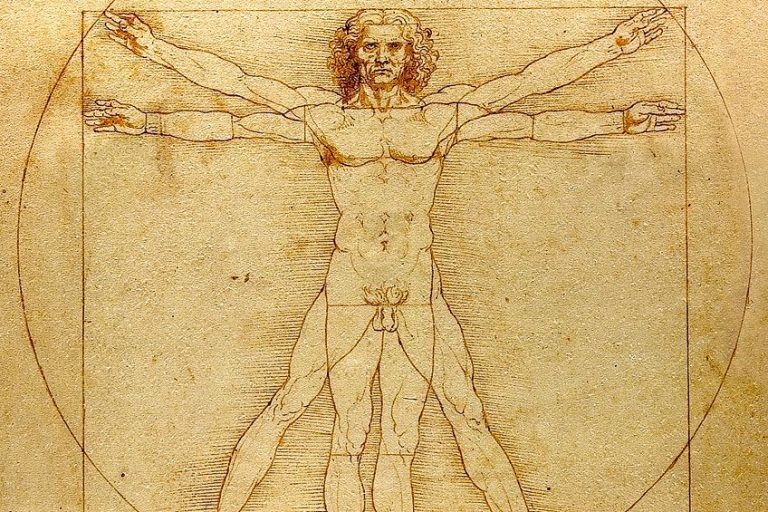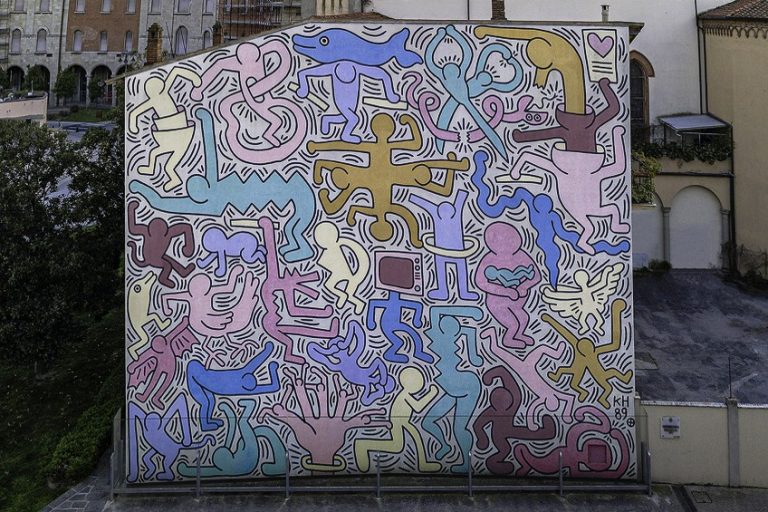Famous Fruit Paintings – Explore the World of Still Life Fruit
Almost every artist has found themselves in a position of asking themselves, “what do I paint?”, at some point. Sometimes the simple subjects are the ones we see every day and are right in our kitchen! From the old masters to the modernists of the 21st century, fruit still-lifes have formed the basis of every artist’s portfolio. In this article, we will journey through time to explore some of the most famous paintings of fruit that you can reminisce on, as well as the symbolism of fruit in painting as seen through art history.
From Apples to Oranges: The Symbolism of Fruit in Painting
Some of your favorite fruits have either been the subject of many well-known still-lifes or featured in some of art history’s most beautiful paintings. Although the subject may seem simple, the history of fruit in art dates back almost 3,000 years ago to ancient Egypt in the form of still-life paintings. These ancient still-life paintings were commonly found in burial tombs and were seen as readymade meals for the dead to enjoy in the afterlife. It is understood that portraiture painting is a way of immortalizing the subject for remembrance long after they have left the physical plane of existence, yet, to immortalize some fruit for specific usage in the afterlife is another level to which artists and ancient peoples viewed still life fruit painting.
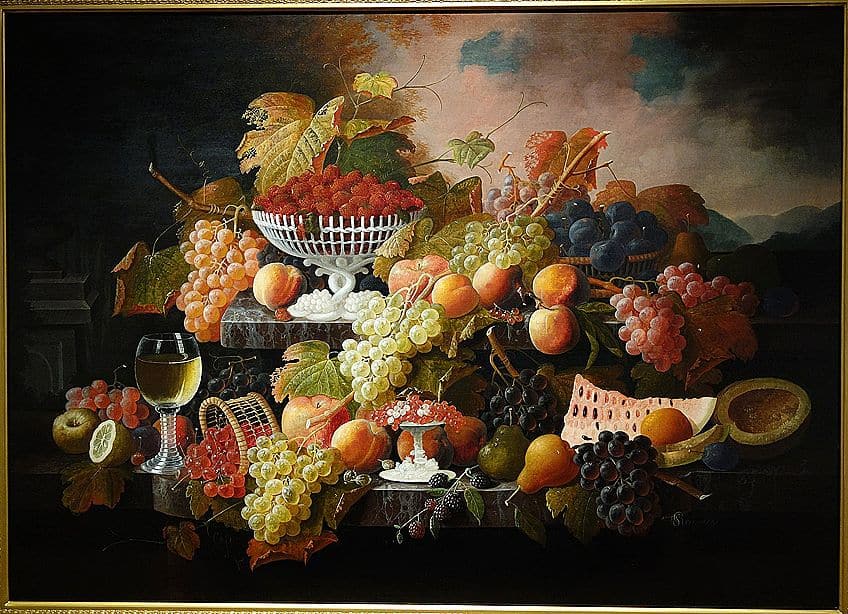
The ancient Romans also represented fruit in mosaic art to signal their openness to hospitality to their guests and was also identified as an emblem of the seasons. Other connotations associated with fruit in art history include allegorical meanings related to the passage of time, the fragility of human life, pleasure, fertility, youth, and abundance.
The state of which fruit was presented in paintings was also indicative of the message that the artists wished to relay and ranged from an emphasis on human mortality through decay to the wealth and earthly pleasure experienced through the freshness and supple aesthetic of fruit.
The Top 10 Most Famous Fruit Paintings
There is more to the image of fruit than its appearance and some of the best master painters have proved this through their creative expressions and painting techniques. Below, we will look at some of the most famous paintings of fruit in art history as well as their symbolic meanings. In other cases, a painting of fruit is simply a fun study!

Rudolf II of Habsburg as Vertumnus (c. 1590 – 1591) by Giuseppe Arcimboldo
| Artist | Giuseppe Arcimboldo (1526 – 1593) |
| Date | c. 1590 – 1591 |
| Medium | Oil on panel |
| Dimensions (cm) | 70 x 57 |
| Where It Is Housed | Skokloster Castle, Skoklosters, Sweden |
This fascinating fruit painting was created by Guiseppe Arcimboldo in 1590 and was modeled after Emperor Rudolf II, the Holy Roman Emperor and ruler over Croatia and Hungary. Guiseppe Arcimboldo was an imaginative painter whose imagination took flight through his fruit portraits. Rudolf II of Habsburg as Vertumnus portrays the emperor as the Roman God of seasons, who was also the God of fruit. The painting served as an imperial allegory through the portrayal of many species of flowers and fruits as a nod to the golden era of the emperor’s reign.
The painting was executed in a Mannerist style and is one of the artist’s most famous fruit paintings.
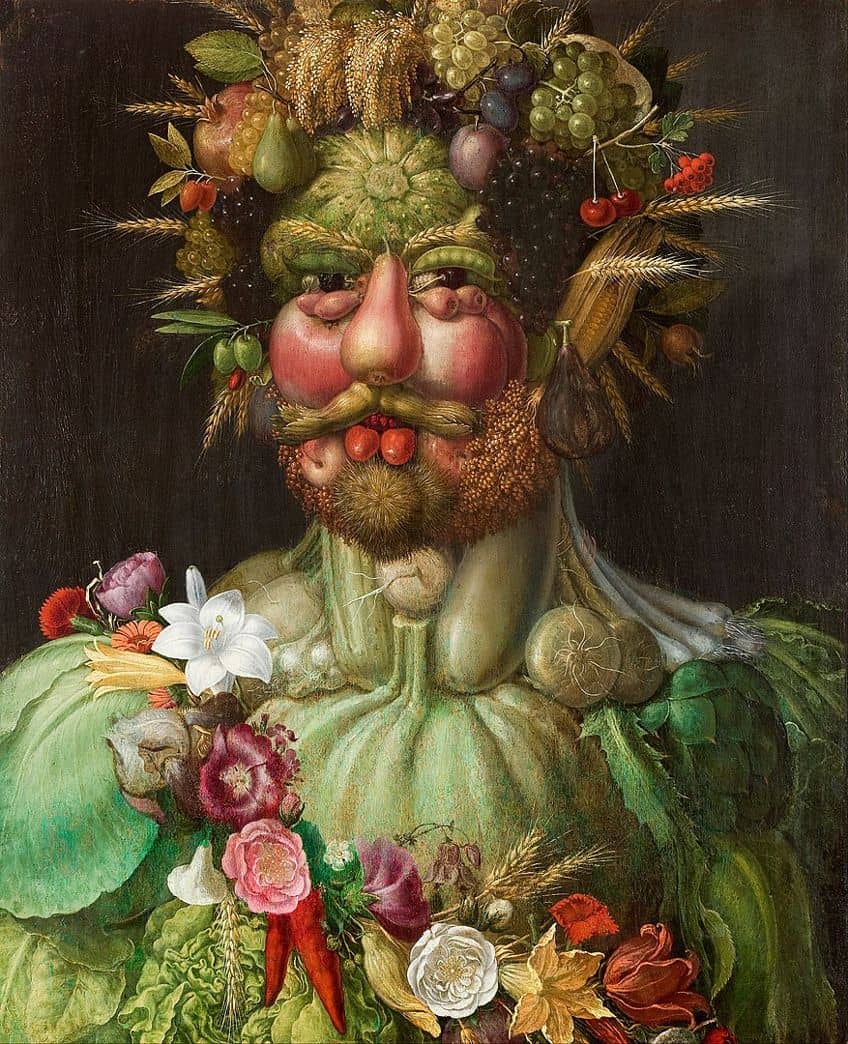
Still Life with Grapes and Other Fruit (c. 1630) by Luca Forte
| Artist | Luca Forte (c. 1615 – 1670) |
| Date | c. 1630 |
| Medium | Oil on copper |
| Dimensions (cm) | 31.4 x 25.9 |
| Where It Is Housed | The J. Paul Getty Museum, Los Angeles, United States |
This famous still-life fruit painting was created by the Italian Baroque painter Luca Forte of whom not much is known, yet his Still Life with Grapes and Other Fruit remains an iconic fruit painting from the 17th century. The still-life presents a gorgeous image of abundance, represented by the luscious-looking grapes, and emphasized by the roundness of the apples below. The painting also possesses an enamel-looking finish made clear by the drops of moisture on the fruit. Forte also included little insects and snails with a pomegranate lying in the lower left corner, alluding to the theme of abundance. The painting was created on a copper surface, which together with the fine brushwork, made for a stunning fruit painting.
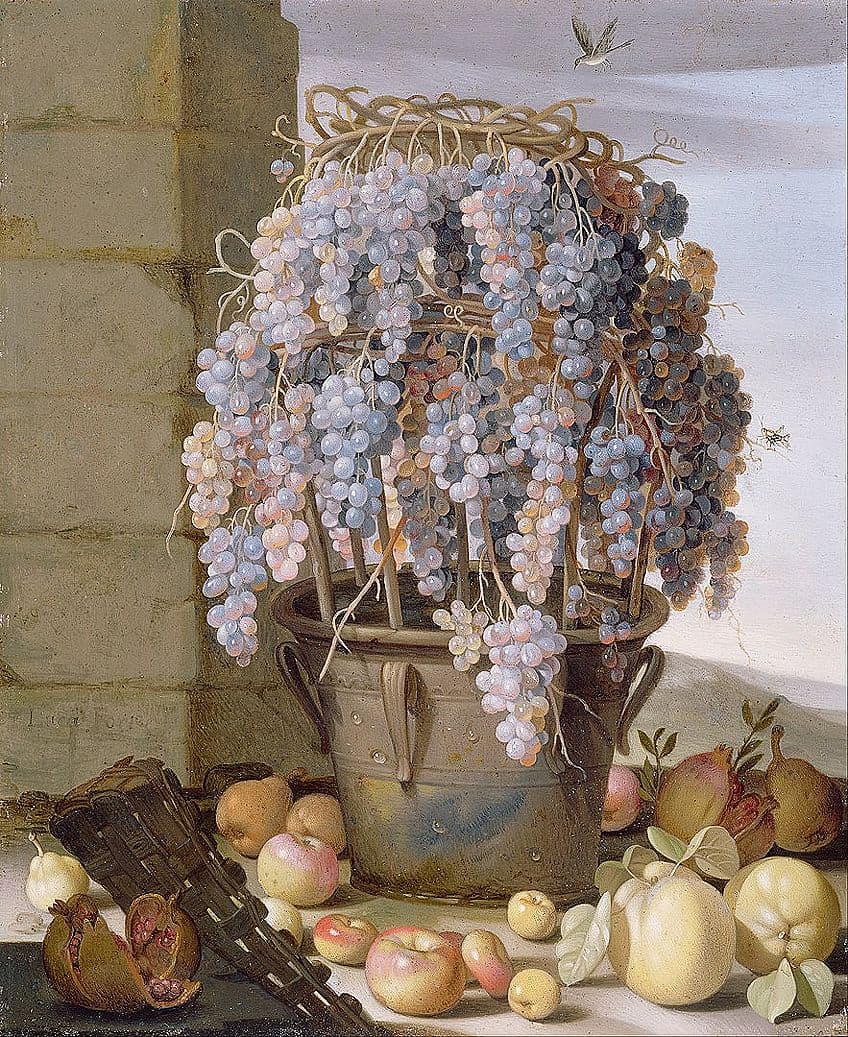
Frontispiece (1850 – 1853) by Dorothea Eliza Smith
| Artist | Dorothea Eliza Smith (1804 – 1864) |
| Date | 1850 – 1853 |
| Medium | Watercolor on paper |
| Dimensions (cm) | Unavailable |
| Where It Is Housed | Oak Spring Garden Foundation, Upperville, Virginia, United States |
Frontispiece is a famous fruit still-life painting by botanical artist Dorothea Eliza Smith. This famous fruit still-life demonstrates the technical talents of Smith and her ability to curate a variety of fruits in an organized fashion while maintaining accuracy in her detailed renderings. Her painting presents temperate fruits with a label stating: “A group of different sorts of fruit: the Manzana-helada (or frozen-apple), cut in the center of the group”.
The fruit still-life was made as a tribute to the moment when each fruit reaches its full ripeness as well as a reflection of beauty and fragrance.
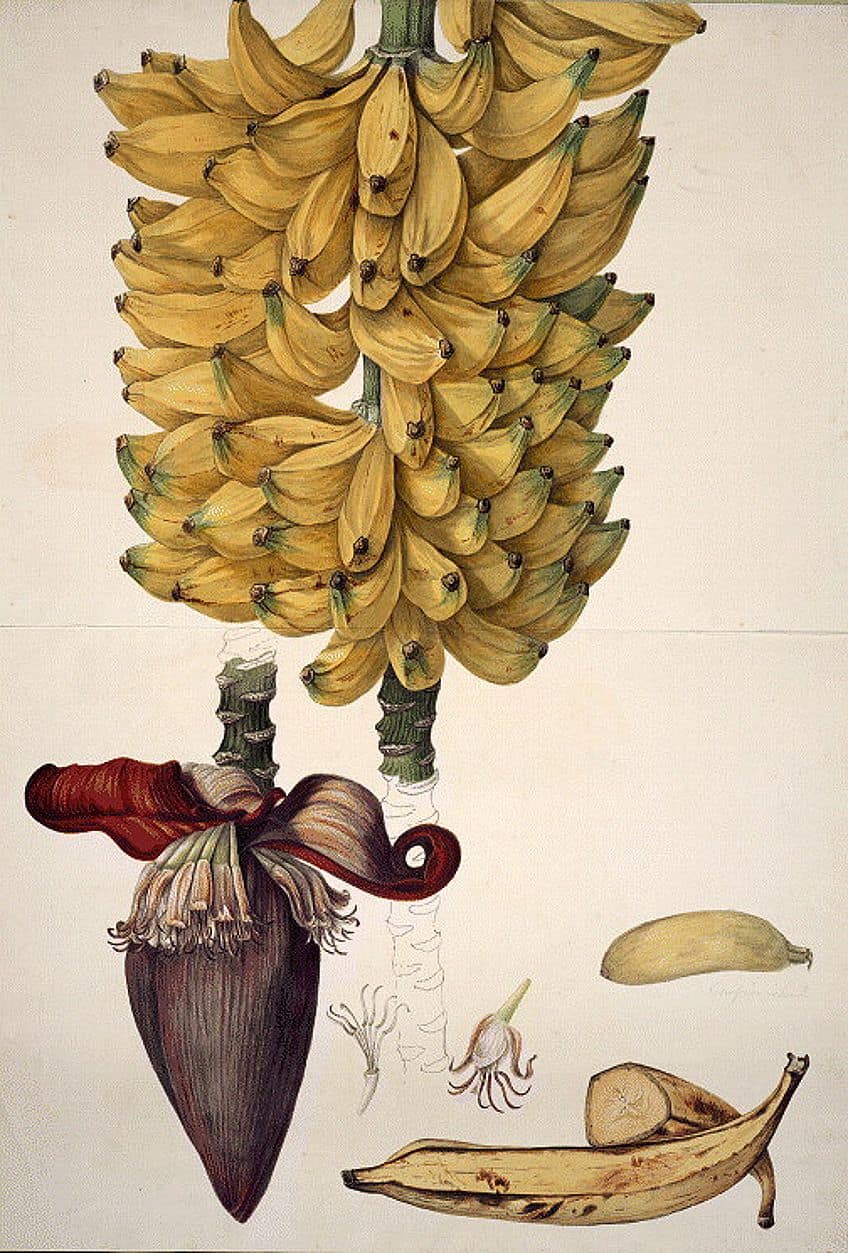
Quinces, Lemons, Pears, and Grapes (1887) by Vincent van Gogh
| Artist | Vincent Willem van Gogh (1853 – 1890) |
| Date | 1887 |
| Medium | Oil on canvas |
| Dimensions (cm) | 46 x 55 |
| Where It Is Housed | Van Gogh Museum, Amsterdam, Netherlands |
This magnificent fruit painting is one of the most famous paintings of fruit by post-Impressionist Vincent van Gogh, which was created in the late 19th century. The painting was initially a landscape painting but Van Gogh chose to instead focus on a simple still-life of Quinces, Lemons, Pears, and Grapes. The painting was also made for the artist’s brother and art dealer, Theo, who encouraged Van Gogh to incorporate more color into his work. Van Gogh’s still-life exudes all things color by focusing solely on the variation of a single color, yellow, and highlighting the strength of its variety in tones of ochre separated by sap greens and peachy nudes. In art history, the pear was affiliated with the Chinese belief that the fruit was a symbol of immortality with the words li translating to both “separation” and “pear”. Instead of a landscape, Van Gogh immortalized the expression of color through the pear and the spillage of its essence onto the frame of the painting, which was also covered in yellow.

Lady With a Fruit (1894) by Raja Ravi Varma
| Artist | Raja Ravi Varma (1848 – 1906) |
| Date | 1894 |
| Medium | Oil on canvas |
| Dimensions (cm) | 45 x 60 |
| Where It Is Housed | Raja Ravi Varma Heritage Foundation, Bengaluru, India |
Lady With a Fruit is a famous fruit painting created by Indian artist Raja Ravi Varma in the late 19th century. Varma was exposed to art and poetry from an early age and later amassed much fame, so much so that he was even sought out by royal figures. Varma’s contemporary eye and interpretation of classical and mythological narratives are what made his work stand out and was a strong advocate for making his work accessible and affordable to all. Lady With a Fruit illustrates a woman holding an orange and is among the artist’s most well-known paintings. In art history, the orange was a symbol of wealth and prosperity.
In Hinduism and Buddhism, the color orange is considered sacred and is associated with purity.
Still Life with Apples (1895 – 1898) by Paul Cézanne
| Artist | Paul Cézanne (1839 – 1906) |
| Date | 1895 – 1898 |
| Medium | Oil on canvas |
| Dimensions (cm) | 92.7 x 68.6 |
| Where It Is Housed | The Museum of Modern Art, New York City, United States |
Still Life with Apples is a well-known still-life painting with fruit created by post-Impressionist Paul Cézanne in the late 19th century. The painting mirrors Cézanne’s beliefs at the time when still-life painting was not fully respected by a 19th-century French artist. By creating this fruit painting, Cézanne drew attention to the process and intention for painting and illuminated viewers on his process, claiming that painting from nature was not necessarily copying it, rather, it was a realization of one’s sensations. The artist further elevated the still-life by offering multiple views and breaking away from the traditional linear perspective. The different angles can be identified by the way the tablecloth shifts into the distance toward the curtain. What stands out the most is the unfinished quality of the work, which perhaps adds to the message of the painting, that is, the imitation of life through a visual experience of seeing.

Pomegranates; Majorca (1908) by John Singer Sargent
| Artist | John Singer Sargent (1856 – 1925) |
| Date | 1908 |
| Medium | Oil on canvas |
| Dimensions (cm) | 73 x 56.5 |
| Where It Is Housed | Private collection |
Pomegranates are an early 20th-century oil painting by famous American Impressionist John Singer Sargent who illustrates the ripeness of the fruit by exposing the bright red pips of the pomegranate. Sargent was a name familiar to all, especially after his “controversial” painting, Portrait of Madame X (1884) was released. Pomegranates were executed with a degree of Realism at the forefront of Sargent’s mind with a clear focus on drawing attention to the abundance that the fruit represents. According to ancient Greco-Roman beliefs, pomegranates were considered to be a sacred fruit that represented feminine fertility.
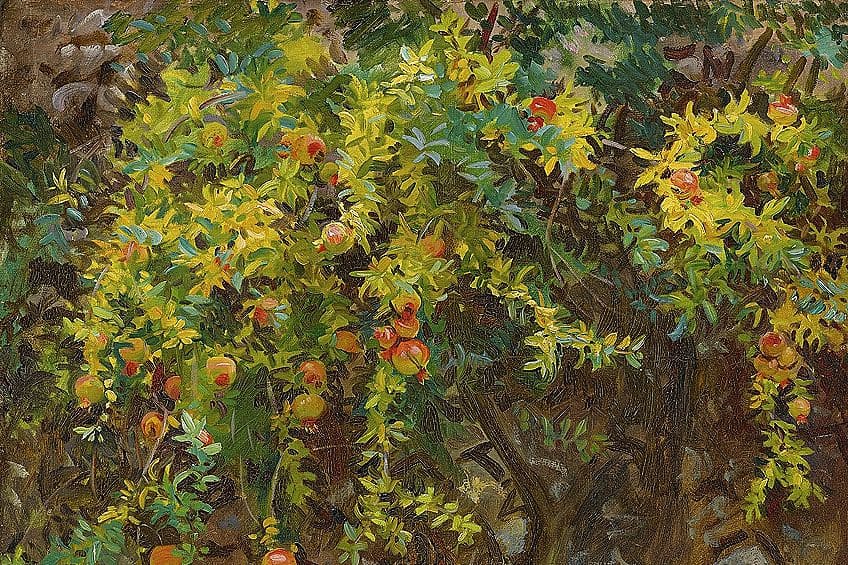
A myth surrounding the pomegranate was founded on the story of Pluto and Proserpina when Pluto kidnapped Proserpina and took her to the underworld. Ceres, her mother, was so distressed that the land grew cold and barren. According to the Fates, if one consumed food in the underworld, they would remain there indefinitely, but Proserpina had already eaten pomegranate seeds before being abducted and was confined to the underworld until winter.
The fruit had since gained affiliation with a forbidden fruit due to its association with the narrative of Pluto and Proserpina.
Eve (1919) by Ochiai Rōfū
| Artist | Ochiai Rōfū (1896 – 1937) |
| Date | 1919 |
| Medium | Color on paper |
| Dimensions (cm) | 351.5 x 172.2 |
| Where It Is Housed | Yamatane Museum of Art, Tokyo, Japan |
Eve is a popular Japanese painting by Modernist painter Ochiai Rōfū whose artworks reflect influences from both Japanese and European cultures. The artist grew up in a Christian household and was inspired by the Fauvist approach to color that mimics some of the color palettes seen in the work of post-Impressionists like Paul Gauguin. The fruit painting, Eve, illustrates a scene of the biblical character Eve who is picking fruit from a tree. Traditionally, Eve would be represented as a white woman in art, yet here, she appears Indian. The fruit associated with this narrative is also an apple, yet Ochiai chose to replace the fruit with a peach. While the painting received mixed reviews and a lot of criticism for having “many issues”, the symbol of the peach goes back to Chinese and Japanese cultural beliefs that identify the peach as a symbol of longevity and a fruit that wards off evil spirits. Peaches in Western-European history also symbolize fertility, feminine sexuality, and the fleeting nature of life.
Oranges and Lemons (1925 – 1926) by Julio Romero de Torres
| Artist | Julio Romero de Torres (1874 – 1930) |
| Date | 1925 – 1926 |
| Medium | Oil on canvas |
| Dimensions (cm) | 75 x 104 |
| Where It Is Housed | Museo Julio Romero de Torres, Córdoba, Spain |
Oranges and Lemons are among the most famous still-life fruit paintings created by Spanish painter Julio Romero de Torres in the 20th century. The painting reflects Torres’ interpretation of the classical theme of still life and includes a standing nude woman who holds the oranges in her hands against her body. In the distant background on the left, one can see the lemons on the lemon tree. Torres’ painting is filled with sensuality yet it also makes the presence of the woman known through the negation of her body from the title of the painting.
One could also argue that the painting reflects the same negation of women in art and inclusion only via their naked bodies.
Viva la Vida (1954) by Frida Kahlo
| Artist | Magdalena Carmen Frida Kahlo y Calderón (1907 – 1954) |
| Date | 1954 |
| Medium | Oil on Masonite |
| Dimensions (cm) | 72 x 52 |
| Where It Is Housed | Museo Frida Kahlo, Mexico City, Mexico |
Viva la Vida is one of the most recognizable fruit paintings of the 20th century, created by Mexican artist Frida Kahlo whose unique style and exploration of Mexican culture and personal identity remain iconic. The painting illustrates vibrant open-cut watermelons and is recognized as Kahlo’s tribute to life itself. Kahlo created this optimistic fruit painting during a period when her health was declining. The phrase written on the painting was executed only eight days before she passed away. The vibrancy of the still-life can be said to represent the hope that death brings and the potential to rest from the suffering of life. Viva la Vida represents a vibrant celebration of life.
These famous fruit paintings offer interesting insight into the different ways that the representation of fruit in fine art can be interpreted and displayed. What makes for a good fruit painting is not only symbolism, composition, and technical execution, but also the context and character of the artist and the environment that surrounds an artwork. We hope that you have enjoyed reviewing the top 10 most famous fruit paintings in art history!
Take a look at our fruit paintings webstory here!
Frequently Asked Questions
What Are Fruit Paintings?
Fruit paintings are also referred to as still-life paintings since they portray inanimate objects and usually feature a variety of selected fruit or vegetables as the subject of the painting.
What Does Fruit Symbolize in Art?
The presence of fruit in an artwork is often associated with still-life painting and can carry different connotations. In most cases, fruits symbolize prosperity, wealth, abundance, pleasure, fertility, and the fleeting nature of life, depending on the composition, color, and presentation of the fruit.
Who Is the Most Famous Fruit Painter?
The most famous fruit-painting artist is considered to be Giuseppe Arcimboldo, who was a renowned Italian artist who specialized in painting portraits of people in the style of fruit compositions.
Isabella studied at the University of Cape Town in South Africa and graduated with a Bachelor of Arts majoring in English Literature & Language and Psychology. Throughout her undergraduate years, she took Art History as an additional subject and absolutely loved it. Building on from her art history knowledge that began in high school, art has always been a particular area of fascination for her. From learning about artworks previously unknown to her, or sharpening her existing understanding of specific works, the ability to continue learning within this interesting sphere excites her greatly.
Her focal points of interest in art history encompass profiling specific artists and art movements, as it is these areas where she is able to really dig deep into the rich narrative of the art world. Additionally, she particularly enjoys exploring the different artistic styles of the 20th century, as well as the important impact that female artists have had on the development of art history.
Learn more about Isabella Meyer and the Art in Context Team.
Cite this Article
Isabella, Meyer, “Famous Fruit Paintings – Explore the World of Still Life Fruit.” Art in Context. February 14, 2023. URL: https://artincontext.org/famous-fruit-paintings/
Meyer, I. (2023, 14 February). Famous Fruit Paintings – Explore the World of Still Life Fruit. Art in Context. https://artincontext.org/famous-fruit-paintings/
Meyer, Isabella. “Famous Fruit Paintings – Explore the World of Still Life Fruit.” Art in Context, February 14, 2023. https://artincontext.org/famous-fruit-paintings/.






